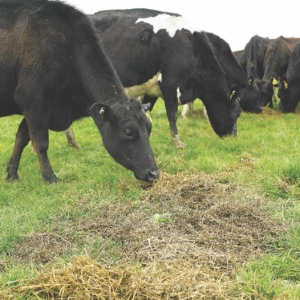Complex diets
Ruminant diets include pasture, concentrates and fibre sources (hay and silage). All these feedstuffs increase the exposure of animals to mycotoxins. The interaction between mycotoxins often leads to synergistic effects, when the negative effect of one mycotoxin is amplified by the presence of another.
High-yielding cows
With increasing milk yield, cows are given larger amounts of feed and passage rate is higher. As such, less time is available for complete digestion and degradation of mycotoxins by rumen microorganisms.
Questionable rumen degradation
Some mycotoxins are converted into metabolites that retain or increase their biological activities, such as aflatoxins and zearalenone, respectively. Notably, drastic changes in feed composition and a high percentage of protein-rich concentrates in the diet modify the cleavage capacity of rumen microorganisms exacerbating the situation (1).
Rumen dysfunction
Mycotoxins in the rumen also exhibit antimicrobial, anti-protozoal and antifungal activity. If rumen microflora is unable to degrade the mycotoxins they will escape the rumen intact and reach the site of intestinal absorption, thus harming the animal (1). Mycotoxins are also known to decrease ruminal motility and dry matter, acid detergent fibre and starch digestion (2).
Infertility
Zearalenone (ZEN) is an estrogenic metabolite reported to occur worldwide in silage (Figure 1), hay, corn and other grains such as soybeans, wheat, barley, oats and sorghum. Chemically, ZEN shows a similar configuration to that of oestradiol, the female hormone, thus impairing animal fertility.
At least 90% of ingested ZEN is converted into a-zearalenol (about 10 times more estrogenic) in the rumen (5). Vulvar mucous discharge, repeated AI, increased culling due to infertility and difficult heat detection are some of the problems which may be related with ZEN intake by cows (3).
Milk production
Deoxynivalenol (DON or vomitoxin) (also shown in Figure 1) has been associated with reduced feed intake and weight gain and decreased performance (4).
Human health
The most worrying aspect of mycotoxins in dairy is their impact on human health. Carcinogenic aflatoxins are carried over into milk as aflatoxin M1 (AfM1). Carry-over rates range from 1.8% to 6.2%, depending on contamination of feed and milk yield(5).
Metabolic problems
Figure 2 summarises the effects of mycotoxins in dairy cattle. Subclinical mycotoxicoses are common and lead to a decrease in profitability by lowering milk production and quality and an increase in expenses due to additional veterinary intervention.
Mycotoxin Risk Management
Biomin has devoted 30 years of research on mycotoxin deactivation. The best way to manage mycotoxins is with a triple assault strategy – 1) adsorption, 2) biological degradation and 3) protection of the liver and immune system.
Mycofix Plus 3.E, registered in New Zealand, helps in the management of aflatoxins and of the adverse effects caused by mycotoxins.
• Inês Rodrigues is technical manager, Biomin Singapore Pte Ltd. Email:This email address is being protected from spambots. You need JavaScript enabled to view it..
References are available from the author upon request.









